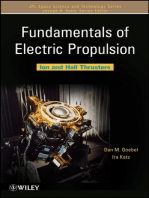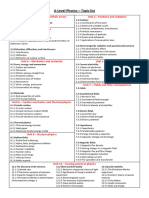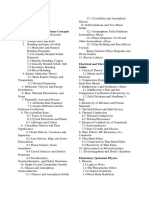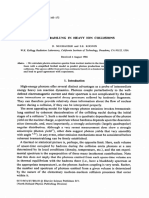0 ratings0% found this document useful (0 votes)
5 viewsTopic List - A Level
All the list
Uploaded by
lubanajaskaran321Copyright
© © All Rights Reserved
Available Formats
Download as DOCX, PDF, TXT or read online on Scribd
0 ratings0% found this document useful (0 votes)
5 viewsTopic List - A Level
All the list
Uploaded by
lubanajaskaran321Copyright
© © All Rights Reserved
Available Formats
Download as DOCX, PDF, TXT or read online on Scribd
You are on page 1/ 2
A-Level Physics – Topic list
Unit 1 – Measurements and their errors Unit 2 – Particles and radiation
1.1 Use of SI units and their prefixes 2.1 Particles
1.2 Limitation of physical measurements 2.1.1 Constituents of the atom
1.3 Estimation of physical quantities 2.1.2 Stable and unstable nuclei
Unit 3 – Waves 2.1.3 Particles, antiparticles and photons
3.1 Progressive and stationary waves 2.1.4 Particle interactions
3.1.1 Progressive waves 2.1.5 Classification of particles
3.1.2 Longitudinal and transverse waves 2.1.6 Quarks and antiquarks
3.1.3 Principle of superposition of waves and formation of 2.1.7 Application of conservation laws
stationary waves
2.2 Electromagnetic radiation and quantum phenomena
3.2 Refraction, diffraction and interference 2.2.1 The photoelectric effect
3.2.1 Interference 2.2.2 Collisions of electrons with atoms
3.2.2 Diffraction 2.2.3 Energy levels and photon emission
3.2.3 Refraction at a plane surface 2.2.4 Wave-particle duality
Unit 4 – Mechanics and materials Unit 5 – Electricity
4.1 Force, energy and momentum 5.1 Current electricity
4.1.1 Scalars and vectors 5.1.1 Basics of electricity
4.1.2 Moments 5.1.2 Current-voltage characteristics
4.1.3 Motion along a straight line 5.1.3 Resistivity
4.1.4 Projectile motion 5.1.4 Circuits
4.1.5 Newtons laws of motion 5.1.5 Potential dividers
4.1.6 Momentum 5.1.6 Electromotive force and internal resistance
4.1.7 Work, energy and power Unit 7 – Fields and their consequences
4.1.8 Conservation of energy 7.1 Fields
4.2 Materials 7.2 Gravitational fields
4.2.1 Bulk properties of solids 7.2.1 Newton’s law
4.2.2 The Young modulus 7.2.2 Gravitational field strength
Unit 6 – Further mechanics and thermal physics 7.2.3 Gravitational potential
6.1 Periodic motion 7.2.4 Orbits of planets and satellites
6.1.1 Circular motion
6.1.2 Simple harmonic motion (SHM) 7.3 Electric fields
6.1.3 Simple harmonic systems 7.3.1 Coulomb’s law
6.1.4 Forced vibrations and resonance 7.3.2 Electric field strength
7.3.3 Electric potential
6.2 Thermal physics
6.2.1 Thermal energy transfer 7.4 Capacitance
6.2.2 Ideal gases 7.4.1 Capacitance
6.2.3 Molecular kinetic energy model 7.4.2 Parallel plate capacitor
Unit 8 – Nuclear physics 7.4.3 Energy stored by a capacitor
8.1 Radioactivity 7.4.4 Capacitor change and discharge
8.1.1 Rutherford scattering
8.1.2 Alpha, beta and gamma radiation 7.5 Magnetic fields
8.1.3 Radioactive decay 7.5.1 Magnetic flux density
8.1.4 Nuclear instability 7.5.2 Moving charges in a magnetic field
8.1.5 Nuclear radius 7.5.3 Magnetic flux and flux linkage
8.1.6 Mass and energy 7.5.4 Electromagnetic induction
8.1.7 Induces fission 7.5.5 Alternating currents
8.1.8 Safety aspects 7.5.6 The operation of a transformer
Unit 12 – Turning points in physics
12.1 The discovery of the electron 12.2 Wave-particle duality 12.3 Special relativity
12.1.1 Cathode rays 12.2.1 Newton’s corpuscular theory of light 12.3.1 The Michelson-Morley
12.1.2 Thermionic emission of electrons 12.2.2 Significance of Young’s double slit experiment
12.1.3 Specific charge of an electron experiment 12.3.2 Einstein’s theory of special
12.1.4 Principle of Millikan’s determination 12.2.3 Electromagnetic waves relativity
of the electronic charge, e 12.2.4 The discovery of photoelectricity 12.3.3 Time dilation
12.2.5 Wave-particle duality 12.3.4 Length contraction
12.2.6 Electron microscopes 12.3.5 Mass and energy
You might also like
- Eric Priest - Magnetohydrodynamics of The Sun-Cambridge University Press (2014) PDF100% (3)Eric Priest - Magnetohydrodynamics of The Sun-Cambridge University Press (2014) PDF580 pages
- Revision List For Y11 - Physics 0972 Topic Sub-Topics 1: LightNo ratings yetRevision List For Y11 - Physics 0972 Topic Sub-Topics 1: Light2 pages
- (eBook PDF) Introduction to Electrodynamics 4th Editionpdf download100% (2)(eBook PDF) Introduction to Electrodynamics 4th Editionpdf download53 pages
- (eBook PDF) Introduction to Electrodynamics 4th Edition all chapter instant download100% (6)(eBook PDF) Introduction to Electrodynamics 4th Edition all chapter instant download55 pages
- (eBook PDF) Introduction to Electrodynamics 4th Edition download100% (2)(eBook PDF) Introduction to Electrodynamics 4th Edition download55 pages
- (eBook PDF) Introduction to Electrodynamics 4th Edition download pdf100% (1)(eBook PDF) Introduction to Electrodynamics 4th Edition download pdf50 pages
- Essentials of Electromagnetism - David Dugdale100% (2)Essentials of Electromagnetism - David Dugdale378 pages
- E-Book From Dark Matter to Ordinary Matter - Complete EdditionNo ratings yetE-Book From Dark Matter to Ordinary Matter - Complete Eddition203 pages
- An Introduction To Applied Electromagnetics - and Optics PDF100% (2)An Introduction To Applied Electromagnetics - and Optics PDF374 pages
- Functional Molecular Materials An Introductory Textbook 1st Edition Matteo Atzori download pdf100% (1)Functional Molecular Materials An Introductory Textbook 1st Edition Matteo Atzori download pdf55 pages
- Atomic and molecular spectroscopy basic concepts and applications 1st Edition Rita Kakkar - The special ebook edition is available for download now100% (1)Atomic and molecular spectroscopy basic concepts and applications 1st Edition Rita Kakkar - The special ebook edition is available for download now49 pages
- MSE 141 A Elementary Materials Science ConceptsNo ratings yetMSE 141 A Elementary Materials Science Concepts4 pages
- E-Book From Dark Matter to Ordinary Matter 3rd edNo ratings yetE-Book From Dark Matter to Ordinary Matter 3rd ed172 pages
- Atomic and molecular spectroscopy basic concepts and applications 1st Edition Rita Kakkar - The ebook is ready for instant download and access100% (2)Atomic and molecular spectroscopy basic concepts and applications 1st Edition Rita Kakkar - The ebook is ready for instant download and access40 pages
- Permanent Magnet Electromechanical Devices Materials Analysis and Applications Electromagnetism 1st Edition Edward P. Furlani - Quickly download the ebook to explore the full content100% (2)Permanent Magnet Electromechanical Devices Materials Analysis and Applications Electromagnetism 1st Edition Edward P. Furlani - Quickly download the ebook to explore the full content43 pages
- Full Functional Molecular Materials An Introductory Textbook 1st Edition Matteo Atzori Ebook All Chapters100% (3)Full Functional Molecular Materials An Introductory Textbook 1st Edition Matteo Atzori Ebook All Chapters62 pages
- Full download Functional Molecular Materials an Introductory Textbook First Edition Artizzu pdf docx100% (1)Full download Functional Molecular Materials an Introductory Textbook First Edition Artizzu pdf docx55 pages
- (Ebook) Applied Photovoltaics by Stuart R. Wenham, Martin A. Green, Muriel E. Watt, Richard Corkish ISBN 9781844074013, 1844074013 pdf download100% (1)(Ebook) Applied Photovoltaics by Stuart R. Wenham, Martin A. Green, Muriel E. Watt, Richard Corkish ISBN 9781844074013, 1844074013 pdf download50 pages
- KSEEB-2nd-PUC-Physics-SYLLABUS-FOR-2020-21newNo ratings yetKSEEB-2nd-PUC-Physics-SYLLABUS-FOR-2020-21new5 pages
- Instant Download Functional Molecular Materials An Introductory Textbook 1st Edition Matteo Atzori PDF All Chapters100% (4)Instant Download Functional Molecular Materials An Introductory Textbook 1st Edition Matteo Atzori PDF All Chapters55 pages
- (eBook PDF) Introduction to Electrodynamics 4th Editioninstant downloadNo ratings yet(eBook PDF) Introduction to Electrodynamics 4th Editioninstant download47 pages
- Curriculum Contents - IGCSE Physics 0625No ratings yetCurriculum Contents - IGCSE Physics 06252 pages
- Functional Molecular Materials An Introductory Textbook 1st Edition Matteo Atzori - Quickly download the ebook to explore the full content100% (3)Functional Molecular Materials An Introductory Textbook 1st Edition Matteo Atzori - Quickly download the ebook to explore the full content61 pages
- Functional Molecular Materials an Introductory Textbook First Edition Artizzu 2024 scribd download100% (3)Functional Molecular Materials an Introductory Textbook First Edition Artizzu 2024 scribd download65 pages
- Atomic Astrophysics and Spectroscopy 1st Edition Anil K. Pradhan - The ebook is now available, just one click to start reading100% (2)Atomic Astrophysics and Spectroscopy 1st Edition Anil K. Pradhan - The ebook is now available, just one click to start reading47 pages
- (Ebook) Functional Materials: Advances and Applications in Energy Storage and Conversion by Toshio Naito (Editor) ISBN 9780429468131, 9780429886706, 9780429886713, 9780429886720, 9789814800099, 042946813X, 0429886705, 0429886713, 0429886721 2024 scribd download100% (1)(Ebook) Functional Materials: Advances and Applications in Energy Storage and Conversion by Toshio Naito (Editor) ISBN 9780429468131, 9780429886706, 9780429886713, 9780429886720, 9789814800099, 042946813X, 0429886705, 0429886713, 0429886721 2024 scribd download76 pages
- Comprehensive Handbook of Solved Physics ProblemsNo ratings yetComprehensive Handbook of Solved Physics Problems4 pages
- (Ebook) Functional Materials: Advances and Applications in Energy Storage and Conversion by Toshio Naito (Editor) ISBN 9780429468131, 9780429886706, 9780429886713, 9780429886720, 9789814800099, 042946813X, 0429886705, 0429886713, 0429886721 - Quickly download the ebook to never miss important content100% (1)(Ebook) Functional Materials: Advances and Applications in Energy Storage and Conversion by Toshio Naito (Editor) ISBN 9780429468131, 9780429886706, 9780429886713, 9780429886720, 9789814800099, 042946813X, 0429886705, 0429886713, 0429886721 - Quickly download the ebook to never miss important content56 pages
- PDF Atomic and molecular spectroscopy basic concepts and applications 1st Edition Rita Kakkar download100% (2)PDF Atomic and molecular spectroscopy basic concepts and applications 1st Edition Rita Kakkar download80 pages
- Functional Molecular Materials an Introductory Textbook First Edition Artizzu - Download the full set of chapters carefully compiled100% (1)Functional Molecular Materials an Introductory Textbook First Edition Artizzu - Download the full set of chapters carefully compiled59 pages
- Instant download Functional Molecular Materials an Introductory Textbook First Edition Artizzu pdf all chapter100% (2)Instant download Functional Molecular Materials an Introductory Textbook First Edition Artizzu pdf all chapter62 pages
- Cambridge IGCSE Physics Study Guide 3rd Edition Sample Pages100% (1)Cambridge IGCSE Physics Study Guide 3rd Edition Sample Pages23 pages
- Atomic and Molecular Physics_ a Primer -- Luciano Prof Colombo -- IOP Expanding Physics, 2021 -- Institute of Physics Publishing -- 9780750322621 -- 087ba2cb3f9abd8a28caf60ae748dd0b -- Anna’s ArchiveNo ratings yetAtomic and Molecular Physics_ a Primer -- Luciano Prof Colombo -- IOP Expanding Physics, 2021 -- Institute of Physics Publishing -- 9780750322621 -- 087ba2cb3f9abd8a28caf60ae748dd0b -- Anna’s Archive219 pages
- Atomic+and+Molecular+Physics+ +FRONT+MATTERNo ratings yetAtomic+and+Molecular+Physics+ +FRONT+MATTER22 pages
- Magnetohydrodynamics of the Sun 2ed. Draft Edition Priest E. instant downloadNo ratings yetMagnetohydrodynamics of the Sun 2ed. Draft Edition Priest E. instant download52 pages
- Functional Materials Advances and Applications in Energy Storage and Conversion 1st Edition Toshio Naito (Editor) pdf downloadNo ratings yetFunctional Materials Advances and Applications in Energy Storage and Conversion 1st Edition Toshio Naito (Editor) pdf download61 pages
- Introduction To Electricity Magnetism and Circuits 1536849524No ratings yetIntroduction To Electricity Magnetism and Circuits 1536849524995 pages
- (Ebook) Magnetohydrodynamics of the Sun by Priest E. ISBN 9780521854719, 0521854717 - The ebook in PDF and DOCX formats is ready for download nowNo ratings yet(Ebook) Magnetohydrodynamics of the Sun by Priest E. ISBN 9780521854719, 0521854717 - The ebook in PDF and DOCX formats is ready for download now60 pages
- Topics in the Theory of Solid Materials 1st Edition J.M. Vail instant download100% (1)Topics in the Theory of Solid Materials 1st Edition J.M. Vail instant download53 pages
- Download Complete Theory of Photon Acceleration 1st Edition J.T Mendonca PDF for All Chapters100% (6)Download Complete Theory of Photon Acceleration 1st Edition J.T Mendonca PDF for All Chapters51 pages
- Download Complete (Ebook) Theory of Photon Acceleration by J.T Mendonca ISBN 9780750307116, 0750307110 PDF for All ChaptersNo ratings yetDownload Complete (Ebook) Theory of Photon Acceleration by J.T Mendonca ISBN 9780750307116, 0750307110 PDF for All Chapters76 pages
- Download ebooks file Topics in the Theory of Solid Materials 1st Edition J.M. Vail all chapters100% (2)Download ebooks file Topics in the Theory of Solid Materials 1st Edition J.M. Vail all chapters67 pages
- Methods of Molecular Quantum Mechanics: An Introduction to Electronic Molecular StructureFrom EverandMethods of Molecular Quantum Mechanics: An Introduction to Electronic Molecular StructureNo ratings yet
- Physics 100A Homework Set 1: Due Friday, June 25th at 5PMNo ratings yetPhysics 100A Homework Set 1: Due Friday, June 25th at 5PM1 page
- 4 Vectors - F - Level - Ii - Mr. Kishore Sharma - Solutions - FinaNo ratings yet4 Vectors - F - Level - Ii - Mr. Kishore Sharma - Solutions - Fina38 pages
- Simplified Multi-Storey Shear Buildoing ModelNo ratings yetSimplified Multi-Storey Shear Buildoing Model22 pages
- Electromagnetic Induction: Mutual InductanceNo ratings yetElectromagnetic Induction: Mutual Inductance14 pages
- Field and Potential Due To Charge Distribution Notes 4aNo ratings yetField and Potential Due To Charge Distribution Notes 4a2 pages
- Lecture 9 (Polar Coordinates and Polar Curves)No ratings yetLecture 9 (Polar Coordinates and Polar Curves)229 pages
- Pc-Saft: Cristian Duvan Sierra Diaz Santiago Andres Gomez Pulido Carlos Andres Montano GuerraNo ratings yetPc-Saft: Cristian Duvan Sierra Diaz Santiago Andres Gomez Pulido Carlos Andres Montano Guerra14 pages
- 2022 - JRWang - ArXiv - Controlling Frustrated Magnetism On The Kagome Lattice by Uniaxial-Strain TuningNo ratings yet2022 - JRWang - ArXiv - Controlling Frustrated Magnetism On The Kagome Lattice by Uniaxial-Strain Tuning7 pages
- CBSE Class 12 Physics Chapter 11 Dual Nature of Radiation and Matter Revision NotesNo ratings yetCBSE Class 12 Physics Chapter 11 Dual Nature of Radiation and Matter Revision Notes36 pages
- Assignment-1 TOE: Pratiksha R Rodewad 5th Semester Aerospace Engineering IIST, Thiruvanthapuram March 28, 2021No ratings yetAssignment-1 TOE: Pratiksha R Rodewad 5th Semester Aerospace Engineering IIST, Thiruvanthapuram March 28, 20217 pages
- A Modern Primer in Particle and Nuclear Physics Francesco Terranova 2024 Scribd DownloadNo ratings yetA Modern Primer in Particle and Nuclear Physics Francesco Terranova 2024 Scribd Download51 pages
- Mathematics Sample Paper Solutions Section-ANo ratings yetMathematics Sample Paper Solutions Section-A19 pages
- Assignment 3: Course: Engineering Mathematics 1 Course Code: ECC 3001 Session: Semester 1 (2016/2017)No ratings yetAssignment 3: Course: Engineering Mathematics 1 Course Code: ECC 3001 Session: Semester 1 (2016/2017)5 pages
- Kalman Decomposition: Observable / Unobservable Decomposition HenceNo ratings yetKalman Decomposition: Observable / Unobservable Decomposition Hence10 pages

























































































